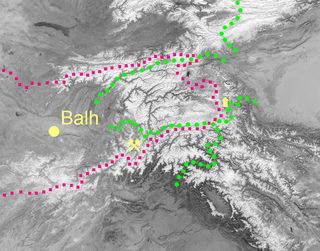 W
WThe Hindu Kush is an 800-kilometre-long (500 mi) mountain range that stretches through Afghanistan, from its centre to Northern Pakistan and into Tajikistan. The range forms the western section of the Hindu Kush Himalayan Region (HKH) and is the westernmost extension of the Pamir Mountains, the Karakoram and the Himalayas. It divides the valley of the Amu Darya to the north from the Indus River valley to the south. The range has numerous high snow-capped peaks, with the highest point being Tirich Mir or Terichmir at 7,708 metres (25,289 ft) in the Chitral District of Khyber Pakhtunkhwa, Pakistan. To the north, near its northeastern end, the Hindu Kush buttresses the Pamir Mountains near the point where the borders of China, Pakistan and Afghanistan meet, after which it runs southwest through Pakistan and into Afghanistan near their border. The eastern end of the Hindu Kush in the north merges with the Karakoram Range. Towards its southern end, it connects with the Spin Ghar Range near the Kabul River.
 W
WThe Karakoram is a mountain range spanning the borders of China, India, and Pakistan, with the northwest extremity of the range extending to Afghanistan and Tajikistan; its highest 15 mountains are all based in Pakistan. It begins in the Wakhan Corridor (Afghanistan) in the west and encompasses the majority of Gilgit-Baltistan (Pakistan) and extends into Ladakh (India) and the disputed Aksai Chin region controlled by China. It is the second highest mountain range in the world and part of the complex of ranges including the Pamir Mountains, the Hindu Kush and the Himalayan Mountains. The Karakoram has eighteen summits over 7,500 m (24,600 ft) height, with four of them exceeding 8,000 m (26,000 ft): K2, the second highest peak in the world at 8,611 m (28,251 ft), Gasherbrum I, Broad Peak and Gasherbrum II.
 W
WMount Imeon is an ancient name for the Central Asian complex of mountain ranges comprising the present Hindu Kush, Pamir and Tian Shan, extending from the Zagros Mountains in the southwest to the Altay Mountains in the northeast, and linked to the Kunlun, Karakoram and Himalayas to the southeast. The term was used by Hellenistic-era scholars as "Imaus Mount", even though non-Greek in etymology, and predating Alexander the Great.
 W
WThe Pamir Mountains are a mountain range between Central Asia, South Asia, and East Asia, at the junction of the Himalayas with the Tian Shan, Karakoram, Kunlun,and Hindu Kush. They are among the world's highest mountains.
 W
WSalang mountains are found in Parwan Province and Baghlan Province in northeastern Afghanistan.
 W
WSpīn Ghar or Safēd Kōh is a mountain range in eastern Afghanistan, which expands into Khyber Pakhtunkhwa, Pakistan. Its highest peak is Mount Sikaram on the Afghanistan–Pakistan border, which towers above all surrounding hills to 4,761 m (15,620 ft) above mean sea level.
 W
WThe Sulaiman Mountains or Kōh-e Sulaymān, are a north–south extension of the southern Hindu Kush mountain system, and rise to form the eastern edge of the Iranian Plateau, and the northeastern edge of the Balochistan Plateau. They are located in the Zabul, Kandahar and Loya Paktia regions of Afghanistan, and in Pakistan they extend over the northern part of Balochistan province, and some parts of southwestern Khyber Pakhtunkhwa and Punjab. Bordering the Sulaimans to the north are the arid highlands of Central Hindu Kush whose heights extend up to 3,383 metres (11,099 ft), and to the east are the Indus plains. Together with the Kirthar Mountains in southern Pakistan, they form what is known as the Sulaiman-Kirthar geologic province.
 W
WWestern Himalaya refers to the western half of the Himalayas, stretching from Badakhshan in northeastern Afghanistan/southern Tajikistan, Pakistan through North India (Jammu and Kashmir, Ladakh and Himachal Pradesh.